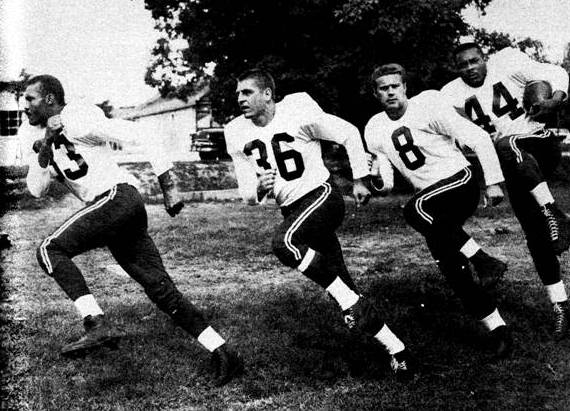

A BRIEF SAGA OF PITTSBURGH STEELERS QUARTERBACKING
HELMET HUT NEWS/REFLECTIONS July 2014:
A BRIEF SAGA OF PITTSBURGH STEELERS QUARTERBACKING
By Dr. Ken
Though I was a New York Giants fan dating from my late 1950’s introduction to professional football, I had a soft spot for some of the poorer teams in the National Football League. If one liked perennial underdogs, there were choices in the 1950’s, despite the cyclical nature of all sports. This is somewhat lost in today’s commercially driven league that is so financially dependent upon fan, media, and corporate involvement. Some teams had consistently solid play and good coaching and though they might have missed the brass ring annually, they gave a good showing and produced name players. Others managed the emergence of a superstar through the decade, allowing for fan interest and reasonable performances. Then there were the hapless and at times, loveable losers.
 |
The excellent 1956 backfield of Ollie Matson, Johnny Olszewski, Lamar McHan, and Dave Mann could not remove the Chicago Cardinals from the bottom of the barrel among NFL teams
Once the teams that were absorbed from the All American Football Conference became “more established” as NFL members, and the last of what would become the defunct squads faded into history’s footnotes, one would expect a number of teams to have an excellent year or two, a few good ones, and perhaps a poor one. Today’s professional football fan has been fed a formula that guarantees mediocrity across the board, a bloated playoff schedule, and manipulation of the rules and scheduling that allow for every team to remain competitive if not year-to-year, at least for most of any specific season, especially within the course of a decade. The concept of parity and having twenty-two teams in a thirty-two team league fighting for a playoff spot as the NFL enters the final week or two of the season makes for big money.
A brief perusal of the record book reveals that the word parity did not apply for those of us who were fortunate enough to grow up and become football fans within the decade of the 1950’s. The Cleveland Browns entered the league and finished far ahead of everyone else with a 92-35-2 record, besting the Giants with their 78-44-3 and the Detroit Lions at 73-49-4 marks. The Bears and Rams qualified as “usually solid” with 70-50-2 and 70-52-3 records respectively while the Cardinals, Packers, and Redskins represented the worst performers. The usually morose Cardinals came out of the 1940’s as a decent squad with a core group of “good” players but they slogged through the ‘50’s posting no better than a horrid .288 winning percentage. Older fans recall that it took Vince Lombardi’s arrival in Green Bay in 1959 to pull them away from their overall .333 win percentage. Prior to “The Lombardi Era” the team’s poor play combined with the small town, relatively isolated and frigid living conditions, made the threat that “If you don’t improve or play harder, you’ll be shipped off to Green Bay” very real and was perhaps the most damning phrase a slumping player could hear.
|
|
Consistently poor play and cold temperatures made Green Bay an avoidable consequence for pro players of the Fifties. Halfback Joe Johnson was one of their better performers in the 1955 season
Somewhere just below the mid-line of the NFL’s pack of twelve teams, sat the Steelers and Eagles. No conference titles, fewer outstanding players than teams with a worse decade-long record, and a reputation for underachieving built upon primarily four-to-six victory seasons left their fans frustrated with a “…if only they could’ve gotten one more score” mentality. Unlike the Cardinals as the most obvious example, the Steelers were never a bottom-of-the-barrel crew that couldn’t get out of their own way but they were the guys that just missed or went into the tank after a promising start. The cornerstones of the Steelers reputation for the decade were unfortunately built upon poor coaching and less than sterling personnel decisions. If the names Earl Morrall